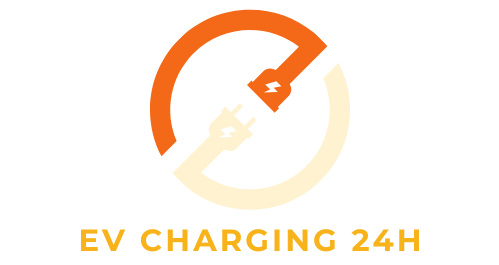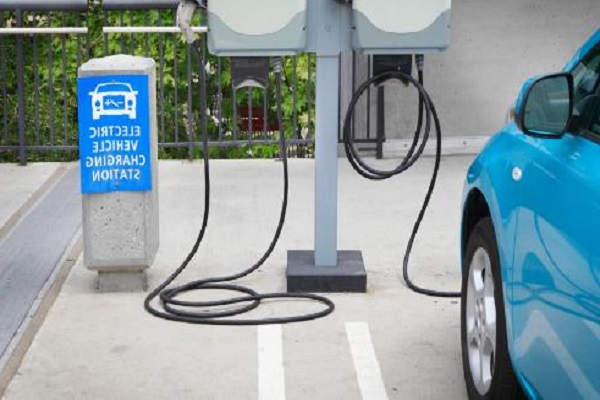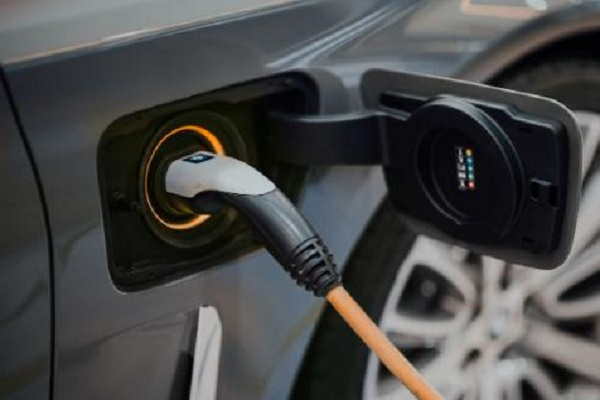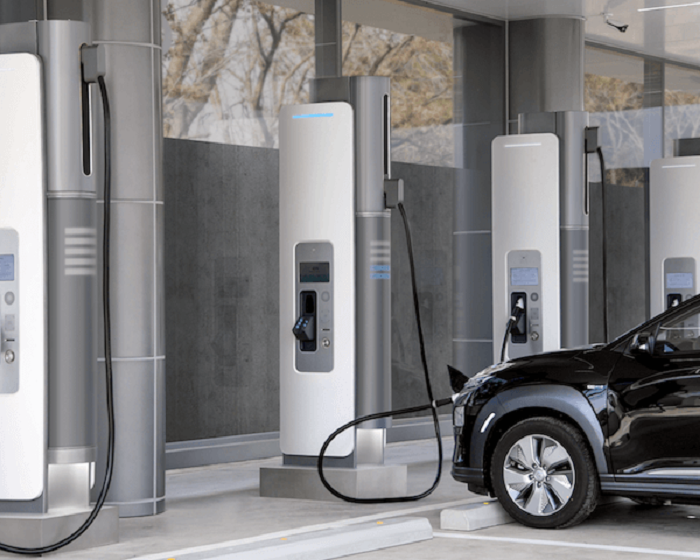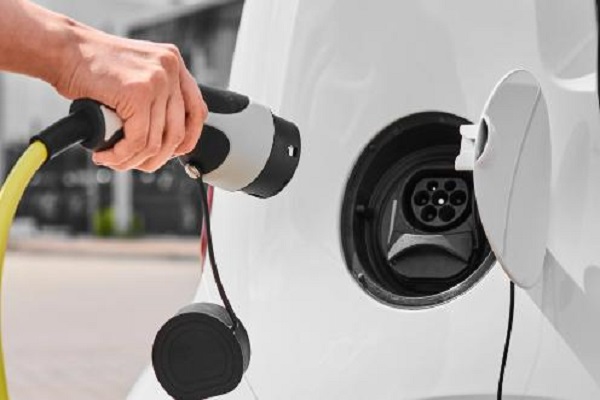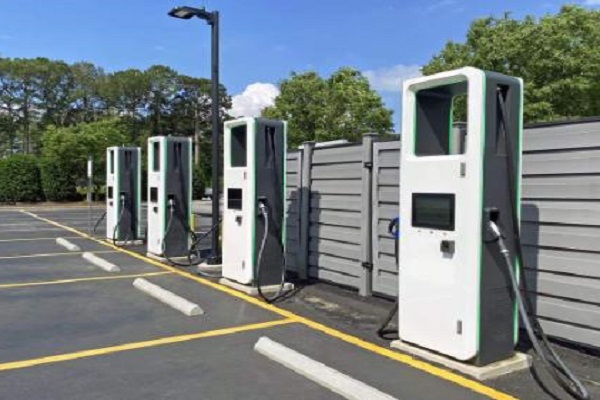Understanding Level 3 EV Charging Station Costs
Level 3 EV chargers, the DC fast chargers of the electric vehicle world, offer the ultimate in charging speed. But this convenience comes at a cost. This guide will delve into the factors that influence Level 3 EV charging station costs, helping you understand the investment involved.
Overview of Level 3 EV Charging Stations

Definition and Technology Behind Level 3 Charging
| Aspect | Description |
| Definition | Level 3 charging, also known as DC fast charging or ultra-fast charging, refers to a high-power charging technology for electric vehicles (EVs) that enables significantly faster charging times compared to Level 1 and Level 2 chargers. |
| Charging Speed | Capable of delivering direct current (DC) electricity at rates typically ranging from 50 kW to over 350 kW, allowing for rapid replenishment of an EV’s battery. |
| Hardware | Equipped with high-power chargers capable of delivering DC electricity, advanced power electronics, cooling systems, and specialized DC connectors. |
| DC connectors | Utilizes specialized DC connectors such as CHAdeMO, CCS (Combined Charging System), or Tesla Supercharger connectors to interface with compatible EVs. |
| Cooling Systems | incorporates sophisticated cooling systems, such as liquid cooling or air-cooled systems, to dissipate heat generated during high-power charging and maintain charging efficiency. |
| Communication Protocols | Uses standardized communication protocols, such as OCPP (Open Charge Point Protocol), to facilitate authentication, billing, and remote monitoring of charging sessions. |
| Grid Connection | It requires a robust electrical connection to the grid to support high-power charging operations, often involving upgrades to local electrical infrastructure and distribution networks. |
Differences Between Level 1, Level 2, and Level 3 Charging
| Aspect | Level 1 Charging | Level 2 Charging | Level 3 Charging |
| Power Source | Standard household 120-volt electrical outlet | Dedicated 240-volt electrical outlet | High-power charging station |
| Power Output (kW) | Typically, 1-2 kW | Typically, 3-19.2 kW | Typically, 50 kW or higher |
| Charging Speed | Slow (4-8 miles of range per hour) | Moderate (10-60 miles of range per hour) | Fast (up to 300 miles of range per hour) |
| Charging Time | Longer charging times, suitable for overnight charging | Faster charging times, suitable for home or public use | Rapid charging times, suitable for long-distance travel |
| Connector Type | Standard household plug (e.g., NEMA 5-15) | SAE J1772 connector or Tesla connector (for Tesla vehicles) | CCS (Combined Charging System), CHAdeMO, Tesla Supercharger, etc. |
| Use Cases | Convenient for occasional or emergency charging | Ideal for daily charging at home, workplaces, or public charging stations | Suited for long-distance travel or quick refueling stops |
| Cost | Relatively inexpensive | Moderate cost for installation of dedicated charging equipment | Higher initial cost for installation of high-power charging stations |
| Infrastructure Requirement | No additional infrastructure required | Requires installation of Level 2 charging equipment | Requires installation of specialized Level 3 charging infrastructure |
| Vehicle Compatibility | Compatible with all electric vehicles (EVs) | Compatible with most EVs, may require an adapter for Tesla vehicles | Compatible with EVs equipped with Level 3 charging capability |
Typical Locations for Level 3 Charging Stations
Highways and Interstates:
Level 3 charging stations are commonly found along major highways and interstates, allowing EV drivers to recharge quickly during long-distance trips. These stations are often located at rest areas, service plazas, or travel centers, providing convenient refueling stops for travelers.
Urban Centers:
Level 3 charging stations are deployed in urban centers, city centers, and downtown areas to support EV drivers living in or visiting densely populated areas. These stations are often installed in public parking lots, garages, or commercial areas, enabling fast charging for urban commuters and residents.
Shopping Centers and Malls:
Level 3 charging stations are installed at shopping centers, malls, and retail outlets to attract EV drivers and encourage longer stays. These stations provide an opportunity for EV drivers to recharge while shopping or running errands, enhancing the shopping experience and supporting sustainability initiatives.
Workplaces and Office Parks:
Level 3 charging stations are increasingly installed at workplaces, office parks, and corporate campuses to support employee commuting and fleet electrification efforts. These stations allow employees to charge their EVs during the workday, reducing range anxiety and promoting sustainable transportation options.
Tourist Destinations:
Level 3 charging stations are located at tourist destinations, attractions, and recreational areas to support EV tourism and travel. These stations enable EV drivers to explore scenic routes, national parks, and cultural sites while having access to fast charging facilities.
Airports and Transportation Hubs:
Level 3 charging stations are installed at airports, train stations, and transportation hubs to cater to EV drivers traveling to and from these locations. These stations provide convenient charging options for travelers using electric rental cars or rideshare services.
Public Infrastructure Projects:
Level 3 charging stations may be included in public infrastructure projects, such as transportation corridors, smart city initiatives, and sustainable development projects. These stations contribute to the expansion of EV charging infrastructure and support government efforts to promote clean energy and reduce emissions.
Benefits of Level 3 Charging for EV Owners
Fast Charging Speeds: Level 3 charging stations can deliver high-power DC electricity, allowing EV owners to recharge their vehicles rapidly. With charging speeds of up to 300 miles of range per hour, Level 3 charging significantly reduces the time needed for charging compared to Level 1 or Level 2 chargers.
Long-Distance Travel: Level 3 charging stations are strategically located along highways and major travel routes, enabling EV owners to embark on long-distance trips with confidence. These stations provide quick refueling stops, allowing drivers to recharge their vehicles and continue their journey without lengthy delays.
Convenience and Flexibility: Level 3 charging stations offer convenience and flexibility for EV owners, providing fast charging options in various settings such as highways, urban centers, shopping malls, and workplaces. With widespread availability and accessibility, Level 3 charging stations make it easier for EV owners to charge their vehicles wherever they go.
Reduced Range Anxiety: Level 3 charging helps alleviate range anxiety among EV owners by providing fast and reliable charging options, especially during long-distance travel. With Level 3 charging stations available at strategic locations, EV owners can recharge their vehicles quickly and continue their journey with peace of mind.
Enhanced Mobility: Level 3 charging facilitates greater mobility and freedom for EV owners, allowing them to explore new destinations and travel longer distances without the fear of running out of battery power. Whether commuting to work, running errands, or embarking on road trips, Level 3 charging stations enable EV owners to stay on the move with minimal disruptions.
Support for Electric Vehicle Adoption: Level 3 charging infrastructure plays a crucial role in supporting the widespread adoption of electric vehicles. By providing fast and convenient charging options, Level 3 charging stations help remove barriers to EV ownership and encourage more drivers to transition to electric vehicles, contributing to sustainability and environmental conservation efforts.
Improved Charging Experience: Level 3 charging stations offer a seamless and user-friendly charging experience for EV owners, with features such as plug-and-charge functionality, easy payment methods, and remote monitoring capabilities. These stations are designed to enhance the overall charging experience and provide EV owners with a hassle-free way to recharge their vehicles.
Challenges and Limitations of Level 3 Charging
High Initial Costs:
Level 3 charging infrastructure requires significant upfront investment in high-power charging equipment, specialized hardware, and electrical infrastructure upgrades. The installation and maintenance costs associated with Level 3 charging stations are often higher compared to Level 1 or Level 2 chargers, posing financial challenges for charging operators and infrastructure providers.
Grid Constraints:
Level 3 charging stations draw high power from the electrical grid, which can strain local distribution networks and cause grid congestion, especially in areas with limited grid capacity. Grid constraints may lead to voltage fluctuations, peak demand charges, and infrastructure upgrades, affecting the reliability and cost-effectiveness of Level 3 charging operations.
Limited Availability:
While Level 3 charging infrastructure is expanding, it remains less widespread compared to Level 1 or Level 2 chargers. EV owners may encounter challenges finding Level 3 charging stations, especially in rural areas, remote regions, or areas with lower EV adoption rates. Limited availability can hinder long-distance travel and increase range anxiety among EV drivers.
Connector Compatibility:
Level 3 charging stations support different connector types, such as CCS (Combined Charging System), CHAdeMO, and Tesla Supercharger, which may require EV owners to use adapters or compatible charging cables. Compatibility issues between charging stations and EV models can inconvenience drivers and limit their charging options, especially when traveling across different regions or countries.
Charging Speed Variation:
While Level 3 charging stations offer fast charging speeds, the actual charging speed may vary depending on factors such as battery state of charge, ambient temperature, charging infrastructure capabilities, and vehicle compatibility. EV owners may experience slower charging speeds than advertised, impacting their charging experience and travel plans.
Cooling and Maintenance:
Level 3 charging stations require robust cooling systems to dissipate heat generated during high-power charging operations. Cooling system failures or inadequate maintenance can lead to overheating, reduced charging efficiency, and increased downtime for charging stations. Regular maintenance and monitoring are essential to ensure the reliability and performance of Level 3 charging infrastructure.
Interoperability and Standards:
The lack of standardized protocols and interoperability between Level 3 charging stations from different manufacturers can create compatibility issues and fragmentation within the charging ecosystem. EV owners may face challenges accessing charging networks, managing billing, and integrating charging data across different platforms, hindering the seamless adoption and utilization of Level 3 charging infrastructure.
Costs Associated with Level 3 EV Charging Stations

Initial Purchase and Installation Costs
The initial purchase and installation costs of Level 3 charging stations can vary depending on factors such as the station’s power output, brand, location, and any necessary electrical upgrades. Here are some key considerations regarding the initial costs:
Equipment Cost:
Level 3 charging stations are more expensive than Level 1 or Level 2 chargers due to their high-power capabilities and specialized hardware. The cost of the charging equipment itself can range from tens of thousands to hundreds of thousands of dollars, depending on the brand, model, and power output of the station.
Installation Expenses:
Installation costs for Level 3 charging stations include site preparation, electrical infrastructure upgrades, permits, labor, and equipment installation. The complexity of the installation process, site-specific requirements, and local regulations can significantly impact installation expenses.
Electrical Upgrades:
Level 3 charging stations require robust electrical connections to support high-power charging operations. Depending on the site’s existing electrical infrastructure, upgrades such as transformer installations, circuit capacity upgrades, and distribution network enhancements may be necessary, adding to the overall installation costs.
Site Preparation:
Site preparation costs may include excavation, grading, concrete pad installation, signage, lighting, and landscaping. The site’s location, terrain, accessibility, and environmental considerations can influence site preparation expenses.
Permits and Regulatory Compliance:
Obtaining permits and complying with local regulations, building codes, zoning ordinances, and environmental requirements incur additional costs. Permitting fees, engineering studies, environmental assessments, and regulatory approvals contribute to the overall initial costs of Level 3 charging station deployment.
Networking and Connectivity:
Level 3 charging stations may require networking and connectivity infrastructure for remote monitoring, management, and payment processing. Costs associated with network hardware, software licenses, data plans, and subscription fees should be factored into the overall installation costs.
Additional Features and Accessories:
Optional features and accessories such as shelter structures, security cameras, EVSE (Electric Vehicle Supply Equipment) management systems, and user interface displays may incur additional expenses but can enhance the functionality, reliability, and user experience of Level 3 charging stations.
Maintenance and Operational Costs
Upkeep of Equipment:
Regular maintenance is essential to ensure the reliability and performance of Level 3 charging stations. Maintenance tasks may include cleaning, inspection, testing, and repair of charging equipment, connectors, cables, and cooling systems. Scheduled maintenance activities help prevent downtime, equipment failures, and costly repairs.
Software Updates and Upgrades:
Charging station software requires regular updates and upgrades to ensure compatibility, security, and performance improvements. Software updates may include bug fixes, feature enhancements, and compliance with industry standards and regulations. Investing in software maintenance and support services is necessary to keep charging stations up-to-date and operational.
Electricity Consumption:
The operational costs of Level 3 charging stations include electricity consumption for charging EVs. Charging station operators may incur electricity expenses based on the energy consumed by charging sessions, demand charges from the utility, and network connectivity requirements. Implementing demand response programs, time-of-use pricing, and energy management strategies can help optimize electricity costs and reduce operational expenses.
Networking and Connectivity:
Level 3 charging stations require networking and connectivity infrastructure for remote monitoring, management, and payment processing. Operational costs associated with networking include data plans, network maintenance, software licenses, and subscription fees for cloud-based services. Ensuring reliable network connectivity and cybersecurity measures is essential to maintain operational efficiency and customer satisfaction.
Customer Support and Service:
Providing customer support and service is crucial for ensuring a positive charging experience and resolving issues promptly. Operational costs may include staffing for customer service representatives, technical support personnel, and onsite maintenance technicians. Offering user-friendly interfaces, self-service options, and responsive support channels helps enhance customer satisfaction and loyalty.
Warranty and Insurance:
Warranty coverage and insurance premiums contribute to the operational costs of Level 3 charging stations. Investing in extended warranties, equipment protection plans, and liability insurance policies helps mitigate financial risks associated with equipment failures, accidents, and legal liabilities.
Monitoring and Analytics:
Implementing monitoring and analytics tools allows charging operators to track charging station performance, usage patterns, and revenue generation. Operational costs may include subscription fees for monitoring platforms, data analytics software, and reporting services. Utilizing data-driven insights helps optimize charging station operations, revenue streams, and customer engagement.
Cost Comparison with Level 1 and Level 2 Stations
| Cost Component | Level 1 Charging | Level 2 Charging | Level 3 Charging |
| Equipment Cost | Relatively low | Moderate | High |
| Installation Cost | Minimal | Moderate | High |
| Maintenance Cost | Minimal | Moderate | High |
| Electricity Consumption | Low | Moderate | High |
| Charging Speed | Slow | Moderate | Fastest |
| Typical Applications | Residential, Emergency | Residential, Commercial | Commercial, Long-Distance Travel |
| Infrastructure Complexity | Simple | Moderate | Complex |
| Usage Scenarios | Overnight charging, Emergency | Daily charging, Workplace | Long-distance travel, Commercial hubs |
| Accessibility | Widely available | Moderately available | Limited availability |
Factors that Influence the Overall Costs
Charging Station Type: The type of charging station—Level 1, Level 2, or Level 3—affects the overall costs. Level 3 charging stations typically have higher upfront costs due to their high-power capabilities and specialized hardware.
Equipment Costs: The cost of charging equipment, including EVSE (Electric Vehicle Supply Equipment) units, connectors, cables, and accessories, varies depending on the charging level, brand, model, and power output of the stations.
Installation Expenses: Installation costs include site preparation, electrical infrastructure upgrades, permitting, labor, equipment installation, and any necessary construction or modifications to accommodate the charging stations.
Electrical Upgrades: Upgrading existing electrical infrastructure or installing new electrical connections to support high-power charging operations adds to the overall costs. This may involve transformer installations, circuit capacity upgrades, and distribution network enhancements.
Site-Specific Factors: Site-specific factors such as location, terrain, accessibility, zoning regulations, environmental considerations, and existing infrastructure influence the overall costs of charging station deployment.
Networking and Connectivity: Networking infrastructure, connectivity solutions, data plans, software licenses, and subscription fees for remote monitoring, management, and payment processing contribute to the operational costs of charging stations.
Maintenance Requirements: Regular maintenance, inspection, testing, repair, and software updates are necessary to ensure the reliability, performance, and safety of charging stations. Maintenance costs include labor, parts, software licenses, and service agreements.
Electricity Consumption: The cost of electricity consumed by charging stations depends on factors such as energy rates, demand charges, time-of-use pricing, charging session duration, and the number of EVs charged.
Customer Support and Service: Providing customer support, technical assistance, and onsite maintenance services incurs additional costs related to staffing, training, equipment, and infrastructure.
Warranty and Insurance: Investing in warranty coverage, equipment protection plans, liability insurance, and cybersecurity measures helps mitigate financial risks associated with equipment failures, accidents, and legal liabilities.
Regulatory Compliance: Complying with regulatory requirements, building codes, standards, and environmental regulations incurs costs related to permitting, engineering studies, environmental assessments, and regulatory approvals.
Market Competition: Market dynamics, competition among charging operators, incentives, subsidies, and funding opportunities influence the overall costs and financial viability of charging station deployment.
Grants and Incentives to Offset Costs
Government Funding Programs:
Federal, state, and local governments offer grants, subsidies, and funding programs to support the deployment of EV charging infrastructure. These programs may provide financial assistance for purchasing charging equipment, installation expenses, and infrastructure upgrades.
Rebate Programs:
Rebate programs offer financial incentives to offset the costs of EV charging equipment and installation. Charging equipment manufacturers, utilities, and government agencies may offer rebates to encourage the adoption of EV charging stations.
Tax Credits and Deductions:
Tax credits and deductions are available to businesses and property owners who invest in EV charging infrastructure. These incentives reduce tax liabilities and provide financial relief for upfront costs associated with charging station deployment.
Utility Incentive Programs:
Utilities offer incentives, grants, and rate structures to support the installation of EV charging stations. Demand response programs, time-of-use pricing, and infrastructure rebates help offset the costs of electricity consumption and encourage the deployment of charging infrastructure.
Public-Private Partnerships:
Public-private partnerships facilitate collaboration between government agencies, utilities, businesses, and non-profit organizations to fund EV charging projects. These partnerships leverage resources, expertise, and funding sources to accelerate the deployment of charging infrastructure.
Environmental Grants:
Environmental grants support projects that promote sustainability, reduce greenhouse gas emissions, and improve air quality. EV charging projects that demonstrate environmental benefits may qualify for grants from environmental organizations, foundations, and philanthropic donors.
Infrastructure Grants:
Infrastructure grants fund the development, expansion, and modernization of transportation infrastructure, including EV charging stations. Government agencies, transportation authorities, and non-profit organizations offer grants to support the construction and operation of charging infrastructure.
Incentive Programs for Businesses and Fleets:
Incentive programs target businesses, fleets, and commercial property owners to encourage the installation of EV charging stations. Incentives may include grants, tax incentives, reduced permitting fees, and technical assistance to facilitate charging infrastructure deployment.
Community Development Grants:
Community development grants support projects that enhance community resilience, economic development, and quality of life. EV charging projects that benefit underserved communities, rural areas, or disadvantaged populations may qualify for community development grants.
Research and Development Grants:
Research and development grants fund innovative projects that advance EV charging technology, improve efficiency, and address technical challenges. Government agencies, industry associations, and research institutions offer grants to support R&D initiatives in the EV charging sector.
Installation Considerations for Level 3 Charging Stations
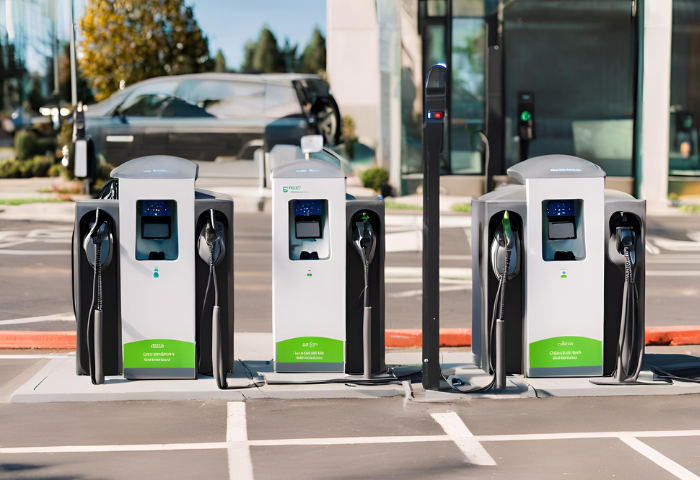
Site Selection Criteria
Accessibility: Choose locations with easy access and visibility for EV drivers. Sites near major highways, urban centers, transportation hubs, shopping malls, hotels, and tourist attractions are preferred to maximize usage and visibility.
Traffic Volume: To draw in more EV drivers, choose busy locations with heavy traffic flow. Charging station use may be reliably guaranteed in locations close to commercial areas, entertainment venues, office parks, and busy crossroads.
Parking Availability: Ensure ample parking space for EV drivers to park and charge their vehicles conveniently. Select sites with dedicated parking spaces, preferably close to the charging stations, to minimize walking distance and maximize accessibility.
Zoning and Land Use: Check local zoning regulations and land use policies to ensure compliance with site selection criteria. Choose sites zoned for commercial, industrial, or mixed-use developments that permit the installation of EV charging infrastructure.
Utilities Infrastructure: Assess the availability and capacity of utilities infrastructure, including electrical connections, transformers, and distribution networks. Ensure sufficient power capacity and upgrade options to support high-power charging operations.
Property Ownership and Leases: Secure permission from property owners or leaseholders to install charging stations on their premises. Negotiate lease agreements, easements, or partnerships to access suitable sites and ensure long-term operational stability.
Safety and Security: Prioritize sites with adequate lighting, visibility, and security features to ensure the safety of EV drivers and charging equipment. Consider factors such as crime rates, vandalism risks, and emergency response capabilities when selecting sites.
Customer Amenities: Choose sites with nearby amenities such as restrooms, restaurants, convenience stores, and Wi-Fi access to enhance the charging experience for EV drivers. Providing additional services and facilities can attract more customers and encourage longer stays.
Environmental Considerations: Consider environmental factors such as air quality, noise levels, and ecological sensitivity when selecting sites. Minimize the impact on the surrounding environment and ecosystems by avoiding protected areas or environmentally sensitive zones.
Community Engagement: Engage with local communities, stakeholders, and EV user groups to gather feedback and input on potential site locations. Consider community preferences, transportation patterns, and demographic trends when evaluating site suitability.
Regulatory Compliance: Ensure compliance with local, state, and federal regulations governing EV charging infrastructure deployment. Obtain permits, approvals, and environmental clearances as required by regulatory authorities and planning agencies.
Future Growth and Demand: Anticipate future growth in EV adoption and demand for charging services when selecting sites. Choose locations with scalability and flexibility to accommodate future expansion and upgrades as EV market trends evolve.
Electrical Infrastructure Requirements
Power Capacity: Determine the power capacity needed to support the charging stations based on their type (Level 1, Level 2, or Level 3), quantity, and power output. Calculate the total power demand to ensure that the electrical infrastructure can accommodate simultaneous charging sessions without overloading the system.
Voltage and Phase: Determine the voltage and phase requirements for the charging stations based on their specifications and electrical standards. Level 1 and Level 2 charging stations typically operate on single-phase 120V or three-phase 208/240V power, while Level 3 charging stations require high-voltage three-phase power.
Electrical Service Panel: Assess the capacity of the existing electrical service panel or main distribution board to determine if it can support the additional load from the charging stations. Upgrade the service panel if necessary to accommodate the increased power demand and ensure compliance with electrical codes and standards.
Circuit Capacity: Install dedicated electrical circuits for each charging station to prevent overloading and ensure reliable power delivery. Size the circuits according to the power rating and current requirements of the charging stations, considering factors such as voltage drop, wire size, and circuit protection devices.
Transformer and Distribution Equipment: Evaluate the capacity and condition of transformers, switchgear, and distribution equipment to ensure they can handle the additional load from the charging stations. Upgrade or retrofit existing equipment as needed to support the increased power demand and improve system reliability.
Conduit and Wiring: Install conduit and wiring to connect the charging stations to the electrical service panel or distribution equipment. Use appropriate wire sizes, insulation types, and wiring methods to comply with electrical codes and standards and minimize voltage drop and electrical losses.
Grounding and Bonding: Ensure proper grounding and bonding of electrical equipment and conductors to prevent electrical hazards and ensure safety. Follow established grounding practices and bonding requirements outlined in electrical codes and standards to protect personnel and equipment from electrical faults.
Metering and Monitoring: Install metering and monitoring equipment to track energy consumption, monitor charging sessions, and manage billing and payment processes. Implement smart metering and monitoring solutions to optimize energy use, identify performance issues, and enhance operational efficiency.
Backup Power Supply: Consider installing backup power supply systems such as uninterruptible power supplies (UPS) or generators to ensure continuity of charging services during power outages or emergencies. Backup power systems provide redundancy and reliability for critical charging infrastructure.
Compliance and Certification: Ensure compliance with local, state, and federal regulations governing electrical installations and EV charging infrastructure. Obtain permits, inspections, and certifications from regulatory authorities and electrical safety organizations to ensure code compliance and operational safety.
Permitting and Compliance Issues
| Permitting and Compliance Issues | Description |
| Zoning Regulations | Understand local zoning ordinances and land use regulations to determine permissible locations for charging stations. |
| Building Codes | Comply with building codes and construction standards to ensure structural integrity, fire safety, and accessibility. |
| Permitting Process | Obtain permits from local building departments, planning agencies, or regulatory authorities before installing charging stations. |
| Environmental Clearances | Conduct environmental assessments and obtain clearances from environmental agencies for installations that may impact protected habitats or sensitive areas. |
| Accessibility Standards | Ensure compliance with accessibility standards, such as the Americans with Disabilities Act (ADA), to provide equitable access to charging facilities. |
| Electrical Inspections | Schedule electrical inspections to verify compliance with electrical codes and standards. |
| Utility Coordination | Coordinate with utility companies to obtain approvals for electrical service connections and grid interconnections. |
| Historic Preservation | Consult with historic preservation boards for installations in historic districts and obtain approvals for alterations to historic structures. |
| Community Engagement | Engage with local communities and stakeholders to address concerns and build support for charging station projects. |
| Regulatory Updates | Stay informed about regulatory changes and industry standards related to EV charging infrastructure. |
Installation Time Frame and Process
| Installation Phase | Duration | Description |
| Site Assessment | 1-2 weeks | Evaluate potential locations for charging stations, assess site suitability, and determine electrical infrastructure requirements. |
| Permitting and Approvals | 2-8 weeks | Obtain necessary permits and approvals from local authorities, regulatory agencies, and building departments. |
| Electrical Infrastructure Preparation | 2-4 weeks | Upgrade or retrofit existing electrical infrastructure to support charging station installation, coordinate with utilities for service connections. |
| Equipment Procurement | 2-6 weeks | Procure EV charging equipment, including stations, connectors, and accessories, ensuring compatibility and timely delivery. |
| Installation and Construction | 2-6 weeks | Prepare the site, install charging stations, mounting hardware, and signage, complete wiring and conduit installation. |
| Testing and Commissioning | 1-2 weeks | Conduct functional testing, electrical inspections, and safety checks to ensure compliance and proper operation. |
| Training and Handover | 1 week | Provide training for personnel and end-users, hand over operational control and documentation, ensure ongoing support. |
Vendor Selection and Evaluation
| Selection Criteria | Description |
| Product Quality | Evaluate the quality, reliability, and durability of charging station equipment, including chargers, connectors, cables, and mounting hardware. |
| Compatibility | Ensure compatibility with EV models, charging standards (e.g., CHAdeMO, CCS, Tesla Supercharger), and networking protocols (e.g., OCPP, ISO 15118). |
| Performance | Assess charging speed, power output, efficiency, and throughput to meet the needs of EV drivers and support high-demand scenarios. |
| Scalability | Consider scalability and future expansion options to accommodate increasing demand, additional charging stations, and evolving technology. |
| Pricing and Cost | Compare pricing, upfront costs, ongoing expenses, and total cost of ownership to ensure affordability and value for money. |
| Warranty and Support | Review warranty coverage, service agreements, technical support, and maintenance services to ensure reliable operation and customer satisfaction. |
| Compatibility | Ensure compatibility with EV models, charging standards (e.g., CHAdeMO, CCS, Tesla Supercharger), and networking protocols (e.g., OCPP, ISO 15118). |
| Technical Expertise | Assess vendor’s technical capabilities, experience, and track record in designing, installing, and servicing EV charging infrastructure. |
| Customer Feedback | Gather feedback from existing customers, user reviews, and case studies to evaluate vendor reputation, customer satisfaction, and reliability. |
| Environmental Impact | Consider environmental certifications, energy efficiency, and sustainability practices to minimize environmental impact and promote eco-friendly solutions. |
| Regulatory Compliance | Ensure compliance with regulatory requirements, safety standards, and certification programs to meet legal obligations and industry best practices. |
Hardware and Technology Options
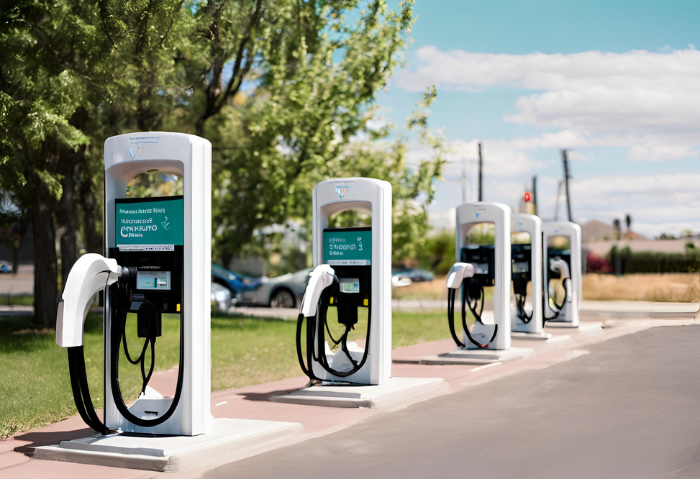
Different Models of Level 3 Chargers
| Charger Model | Manufacturer | Power Output Range | Supported Connectors | Key Features |
| ABB Terra HP | ABB | Up to 350 kW | CCS, CHAdeMO | High-power output, multiple charging standards |
| EVBox Ultroniq | EVBox | 50 kW – 350 kW | CCS, CHAdeMO | Modular design, scalable power, sleek interface |
| Delta DC Wallbox | Delta | 25 kW – 100 kW | CCS, CHAdeMO | Indoor/outdoor installation, compact design |
| ChargePoint Express Plus | ChargePoint | Up to 400 kW | CCS, CHAdeMO | Modular architecture, dynamic power sharing |
| Siemens SICHARGE CC | Siemens | 50 kW – 300 kW | CCS, CHAdeMO | Robust construction, various power configurations |
| Tritium Veefil-PK | Tritium | Up to 475 kW | CCS, CHAdeMO | Liquid-cooled technology, high efficiency |
| BTC Power Ultra-Fast Charger | BTC Power | 100 kW – 350 kW | CCS, CHAdeMO | Ultra-fast charging, suitable for high-traffic areas |
Features and Capabilities of Advanced Chargers
| Feature / Capability | Description |
| High Power Output | Capable of delivering high power outputs, typically ranging from 150 kW to 350 kW or more. |
| Dynamic Power Management | Allocates power dynamically among multiple charging stations based on demand to optimize distribution. |
| Modular Design | Offers scalability and flexibility to add or remove charging modules based on demand. |
| Multiple Connectors | Supports multiple charging standards and connector types such as CCS, CHAdeMO, and Tesla Supercharger. |
| Liquid-Cooled Cables | Equipped with liquid-cooled cables to manage heat during high-power charging sessions. |
| Cloud Connectivity | Enables remote monitoring, management, and firmware updates via cloud-based platforms. |
| Smart Charging Features | Includes load balancing, demand response, and time-of-use pricing for grid optimization. |
| User-friendly Interface | Features intuitive interfaces with touchscreens, mobile apps, and interactive displays. |
| Integration with Energy Management Systems | Integrates with energy management systems and V2G platforms for coordinated control. |
| Safety and Security Features | Incorporates overcurrent protection, ground fault detection, and secure authentication mechanisms. |
Compatibility with Various EV Models
| Charger Model | CCS Compatibility | CHAdeMO Compatibility | Tesla Supercharger Compatibility | Other Compatibility |
| ABB Terra HP | Yes | Yes | No | |
| EVBox Ultroniq | Yes | Yes | No | |
| Delta DC Wallbox | Yes | Yes | No | |
| Siemens Express Plus | Yes | Yes | No | |
| Siemens Siemens CC | Yes | Yes | No | |
| Tritium Veefil-PK | Yes | Yes | No | |
| BTC Power Ultra-Fast Charger | Yes | Yes | No |
Software Integration and User Interface
| Feature | Description |
| Cloud Connectivity | Enables remote monitoring, management, and updates of charging stations via cloud-based platforms. |
| Energy Management Systems | Integrates with energy management systems for optimized charging schedules, load management, and grid interaction. |
| Vehicle-to-Grid (V2G) | Supports vehicle-to-grid integration for bidirectional energy flow, enabling EVs to store and discharge electricity. |
| Mobile App | Provides a mobile application for EV drivers to locate, reserve, and initiate charging sessions remotely. |
| Payment Processing | Facilitates payment processing via mobile apps, RFID cards, credit cards, or other payment methods for user convenience. |
| Real-time Data Monitoring | Offers real-time monitoring of charging status, energy consumption, and billing information for EV drivers and operators. |
| User-friendly Interface | Features an intuitive user interface with touchscreen displays, interactive menus, and visual indicators for easy operation. |
| Customizable Settings | Allows users to customize charging preferences, such as charging speed, energy limits, and scheduling options. |
| RFID Authentication | Supports RFID card authentication for secure access to charging stations and user identification. |
| Over-the-Air Updates | Enables over-the-air updates for firmware upgrades, software patches, and feature enhancements to improve functionality. |
Future Proofing and Technological Scalability
| Feature | Description |
| Modular Design | Incorporates a modular design, allowing for easy expansion or upgrading of charging infrastructure as demand grows. |
| Scalable Power Output | Offers scalable power output options to adapt to future advancFutureproofingements in EV battery technology and charging standards. |
| Compatibility with Emerging Standards | Ensures compatibility with emerging charging standards and protocols to support future EV models and technologies. |
| Smart Grid Integration | Integrates with smart grid technologies for dynamic load management, demand response, and grid stabilization. |
| Vehicle-to-Grid (V2G) Capabilities | Enables bidirectional energy flow between EVs and the grid, allowing EVs to serve as distributed energy resources. |
| Advanced Communication Protocols | Supports advanced communication protocols such as ISO 15118 for secure vehicle-to-infrastructure communication. |
| Over-the-Air Software Updates | Facilitates over-the-air software updates to add new features, enhance performance, and address security vulnerabilities. |
| Future-Proofing Compatibility | Designs charging infrastructure with backward and forward compatibility to accommodate current and future EV technologies. |
User Experience and Accessibility
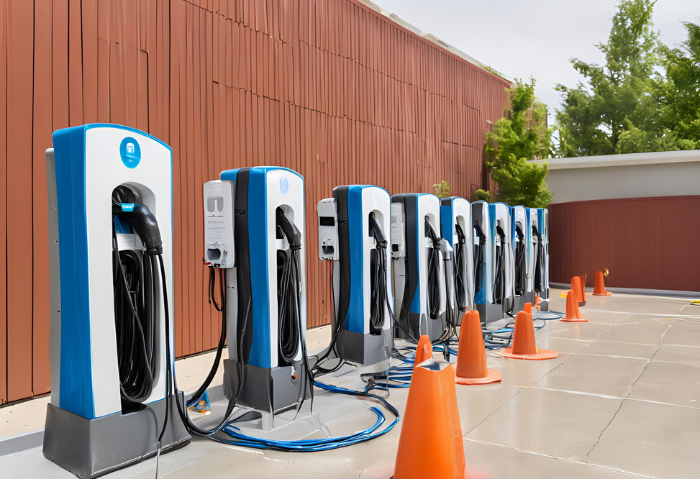
Payment Methods and Pricing Models
| Feature | Description |
| Credit/Debit Cards | Accepts credit and debit card payments for charging sessions, providing convenience for EV drivers. |
| Mobile Payment Apps | Supports payment via mobile apps, allowing users to initiate and pay for charging sessions remotely. |
| RFID Cards | Enables RFID card authentication for secure access to charging stations and streamlined payment processing. |
| Subscription Services | Offers subscription-based pricing models, where users pay a monthly or annual fee for unlimited charging. |
| Pay-Per-Use | Implements pay-per-use pricing models, where users are charged based on the duration or amount of energy consumed during charging sessions. |
| Time-Based Pricing | Utilizes time-based pricing models, where charging rates vary depending on the time of day or demand on the grid. |
| Energy-Based Pricing | Applies energy-based pricing models, where users are billed based on the amount of energy consumed during charging sessions. |
| Flat-Rate Pricing | Offers flat-rate pricing models, where users pay a fixed fee for each charging session regardless of duration or energy consumption. |
| Dynamic Pricing | Implements dynamic pricing algorithms that adjust charging rates in real-time based on factors such as grid demand, electricity prices, and availability of renewable energy. |
| Prepaid Charging Credits | Allows users to purchase prepaid charging credits or vouchers for future use, providing flexibility and budget management. |
Charging Station Availability and Reservation Systems
| Feature | Description |
| Real-Time Availability Status | Provides real-time information on the availability of charging stations, indicating which stations are currently occupied or available. |
| Reservation Functionality | Allows EV drivers to reserve charging slots in advance, ensuring access to charging infrastructure during peak demand periods. |
| User-Friendly Interface | Offers an intuitive interface for users to check station availability, view reservation options, and manage bookings effortlessly. |
| Mobile App Integration | Integrates with mobile applications, enabling users to check availability, make reservations, and receive notifications on the go. |
| Automated Alerts | Sends automated alerts and notifications to users regarding reservation confirmations, cancellations, or changes in station status. |
| Flexible Reservation Policies | Offers flexible reservation policies, allowing users to modify or cancel bookings as needed without incurring penalties or fees. |
| Priority Access for Subscribers | Provides priority access to charging stations for subscribers or members of loyalty programs, enhancing user convenience and loyalty. |
| Dynamic Pricing Integration | Integrates with dynamic pricing systems to adjust reservation fees based on factors such as demand, time of day, and station utilization. |
| Compatibility with Backend Systems | Supports integration with backend systems such as energy management platforms or billing systems for seamless operation and data exchange. |
User Interface and Charger Connectivity
| Feature | Description |
| Touchscreen Interface | Provides a user-friendly touchscreen interface for intuitive interaction with charging stations. |
| Interactive Menus | Offers interactive menus and visual indicators to guide users through the charging process and options. |
| Real-time Charging Status | Displays real-time information on charging status, including current power output, charging rate, and remaining time. |
| Payment Options | Allows users to select and pay for charging sessions using various payment methods, such as credit cards or mobile apps. |
| RFID Authentication | Supports RFID card authentication for secure access to charging stations and user identification. |
| Remote Start/Stop | Enables remote start and stop functionality via mobile apps or web interfaces, allowing users to control charging sessions remotely. |
| OCPP Compatibility | Integrates with Open Charge Point Protocol (OCPP) for standardized communication with backend management systems and network operators. |
| Smart Grid Connectivity | Connects to smart grid technologies for bidirectional communication and integration with energy management systems. |
| Data Logging and Reporting | Logs charging session data and generates reports on energy consumption, usage patterns, and billing information. |
| Firmware Updates | Supports over-the-air firmware updates to ensure chargers remain up-to-date with the latest features and security patches. |
| Network Connectivity | Provides reliable network connectivity options such as Ethernet, Wi-Fi, or cellular connection for seamless operation. |
Accessibility for Users with Disabilities
| Feature | Description |
| ADA Compliance | Adheres to the Americans with Disabilities Act (ADA) standards, ensuring that charging stations are accessible to individuals with disabilities. |
| Accessible Parking Spaces | Provides designated accessible parking spaces adjacent to charging stations, with adequate space for wheelchair maneuverability. |
| Height-Adjusted Interfaces | Offers height-adjusted user interfaces, touchscreens, and payment terminals to accommodate users in wheelchairs or with mobility impairments. |
| Braille Instructions | Includes Braille instructions and tactile signage for users with visual impairments to navigate and operate charging stations independently. |
| Audible Instructions | Provides audible instructions and voice prompts for users with visual impairments or cognitive disabilities to interact with charging stations effectively. |
| Text-to-Speech Conversion | Incorporates text-to-speech conversion functionality, allowing users with visual impairments to receive spoken feedback and instructions during charging sessions. |
| Visual Contrast and Lighting | Ensures adequate visual contrast and lighting conditions at charging stations to assist users with low vision or color blindness in identifying controls and signage. |
| Wide Clearances and Pathways | Maintains wide clearances and pathways around charging stations to accommodate wheelchair users and individuals with mobility aids comfortably. |
| Emergency Call Buttons | Includes emergency call buttons or assistance intercoms for users to request help or report emergencies during charging sessions. |
| Tactile Ground Surface Indicators | Installs tactile ground surface indicators to guide users with visual impairments safely to charging stations and designated parking spaces. |
| Remote Assistance and Support | Offers remote assistance and support options for users with disabilities to receive guidance, troubleshoot issues, or request assistance during charging sessions. |
Customer Support and Services
| Service | Description |
| 24/7 Customer Support | Offers round-the-clock customer support via phone, email, or live chat to assist users with inquiries and issues. |
| On-site Assistance | Provides on-site assistance from trained staff or technicians to troubleshoot issues or provide guidance to users. |
| Remote Diagnostics | Utilizes remote diagnostic tools and monitoring systems to identify and resolve technical issues with charging stations proactively. |
| User Education and Training | Conducts user education and training sessions to familiarize EV drivers with charging station operation, safety procedures, and payment processes. |
| Mobile App Support | Offers support for mobile applications, helping users navigate app features, troubleshoot issues, and provide feedback. |
| Billing and Account Management | Assists users with billing inquiries, account management tasks, and payment disputes related to charging sessions. |
| Regular Maintenance Services | Performs scheduled maintenance and inspections on charging stations to ensure optimal performance and reliability. |
| Firmware Updates | Deploys regular firmware updates and software patches to keep charging stations up-to-date with the latest features and security enhancements. |
| Emergency Response | Implements emergency response protocols to address safety incidents, equipment malfunctions, or power outages promptly. |
| Community Engagement | Engages with the EV community through events, forums, and social media platforms to gather feedback and foster collaboration. |
Energy Sources and Sustainability

Renewable Energy Integration
| Feature | Description |
| Solar PV Integration | Incorporates solar photovoltaic (PV) panels into charging infrastructure to generate renewable electricity. |
| Wind Turbine Integration | Integrates wind turbines to harness wind energy and supplement charging station power supply with renewable energy. |
| Battery Energy Storage | Deploys battery energy storage systems (BESS) to store excess renewable energy for use during charging operations. |
| Smart Charging Algorithms | Utilizes smart charging algorithms to prioritize charging during periods of peak renewable energy generation, optimizing energy use. |
| Vehicle-to-Grid (V2G) Integration | Integrates vehicle-to-grid (V2G) technology to enable bidirectional energy flow between EVs and the grid, supporting renewable energy integration. |
| Dynamic Load Management | Implements dynamic load management strategies to balance charging demand with renewable energy availability and grid constraints. |
| Renewable Energy Certificates | Participates in renewable energy certificate (REC) programs to certify and track the renewable attributes of electricity consumed during charging. |
| Green Tariff Programs | Participates in green tariff programs offered by utilities to source renewable energy for charging operations at preferential rates. |
| Microgrid Integration | Integrates charging infrastructure into microgrid systems powered by renewable energy sources for localized and resilient energy supply. |
| Real-time Renewable Energy Monitoring | Monitors renewable energy generation in real-time and adjusts charging operations accordingly to maximize renewable energy utilization. |
Energy Storage Solutions
| Solution | Description |
| Battery Energy Storage Systems | Deploy battery energy storage systems (BESS) to store excess energy from renewable sources or off-peak periods for later use during charging operations. |
| Ultra-capacitors | Utilize ultra-capacitors to provide short-term energy storage and buffer power fluctuations, enhancing the stability and reliability of charging infrastructure. |
| Flywheel Energy Storage | Incorporate flywheel energy storage systems to store kinetic energy and provide rapid response to grid demand, improving grid stability and energy efficiency. |
| Hydrogen Fuel Cells | Integrate hydrogen fuel cells as an energy storage solution to convert hydrogen into electricity during peak demand or when renewable sources are unavailable. |
| Thermal Energy Storage | Employ thermal energy storage systems to store excess heat generated during charging operations and use it for space heating or cooling purposes. |
| Compressed Air Energy Storage | Implement compressed air energy storage (CAES) systems to store energy in the form of compressed air and release it during peak demand periods for charging. |
| Pumped Hydro Storage | Leverage pumped hydroelectric storage systems to store surplus energy by pumping water uphill and releasing it downhill to generate electricity when needed. |
| Supercapacitors | Utilize supercapacitors as an energy storage solution to provide rapid charging and discharging capabilities, supporting high-power charging applications. |
| Grid-scale Energy Storage | Connect charging infrastructure to grid-scale energy storage facilities, such as large-scale batteries or pumped hydro storage plants, for backup power and grid stabilization. |
Grid Impact and Demand Response
| Feature | Description |
| Grid Impact Analysis | Conducts grid impact studies to assess the potential effects of EV charging on local distribution and transmission grids. |
| Load Balancing | Implements load balancing algorithms to distribute charging demand evenly across charging stations and time periods, minimizing peak loads on the grid. |
| Demand Response Programs | Participates in demand response programs to adjust charging rates or schedules in response to grid conditions or utility signals, supporting grid stability and reliability. |
| Smart Charging Strategies | Utilizes smart charging strategies to shift charging demand to off-peak hours or times when renewable energy generation is high, reducing stress on the grid during peak periods. |
| Dynamic Pricing | Implements dynamic pricing schemes that vary charging rates based on grid conditions, electricity prices, or demand levels to incentivize flexible charging behavior. |
| Vehicle-to-Grid (V2G) | Integrates vehicle-to-grid (V2G) technology to enable bidirectional energy flow between EVs and the grid, allowing EVs to serve as grid resources during peak demand events. |
| Grid Integration Platforms | Connects charging infrastructure to grid integration platforms or energy management systems to facilitate communication, data exchange, and coordination with grid operators. |
| Grid Services Participation | Participates in grid services markets, such as frequency regulation or capacity markets, by providing aggregated charging infrastructure as a flexible grid resource. |
| Predictive Charging Algorithms | Utilizes predictive charging algorithms to anticipate grid conditions and optimize charging schedules to minimize grid impact and maximize renewable energy utilization. |
| Grid-friendly Charging Standards | Adheres to grid-friendly charging standards and protocols, such as ISO 15118, to enable communication between charging infrastructure and grid operators for coordinated charging. |
Carbon Footprint and Environmental Benefits
| Aspect | Description |
| Reduced Carbon Emissions | EV charging infrastructure facilitates the adoption of electric vehicles, which produce zero tailpipe emissions, reducing greenhouse gas emissions and air pollution. |
| Renewable Energy Integration | Integrating renewable energy sources into EV charging infrastructure further reduces carbon footprints by utilizing clean, renewable energy for charging operations. |
| Lifecycle Carbon Analysis | Conducting lifecycle carbon analysis assesses the overall environmental impact of EV charging infrastructure, including manufacturing, operation, and disposal phases. |
| Grid Decarbonization Initiatives | Supporting grid decarbonization initiatives promotes the transition to cleaner energy sources and reduces the carbon intensity of electricity used for charging. |
| Energy Efficiency Measures | Implementing energy-efficient charging technologies and practices minimizes energy consumption and reduces overall carbon emissions associated with charging operations. |
| Carbon Offsetting Programs | Participating in carbon offsetting programs allows EV charging operators to mitigate their carbon footprint by investing in renewable energy projects or carbon sequestration efforts. |
| Environmental Certification | Obtaining environmental certifications, such as LEED or ISO 14001, demonstrates a commitment to sustainable practices and reduces the environmental impact of charging infrastructure. |
| Public Awareness and Education | Raising public awareness and education about the environmental benefits of electric vehicles and charging infrastructure encourages adoption and promotes sustainable mobility. |
| Lifecycle Analysis Tools | Using lifecycle analysis tools and methodologies enables continuous improvement of EV charging infrastructure to minimize environmental impacts throughout its lifecycle. |
| Carbon Reporting and Transparency | Providing transparent carbon reporting allows stakeholders to assess and compare the environmental performance of EV charging infrastructure and make informed decisions. |
Regulations and Standards for Sustainability
| Regulation/Standard | Description |
| Zero-Emission Vehicle (ZEV) Mandates | ZEV mandates require automakers to produce and sell a certain percentage of zero-emission vehicles, driving the adoption of electric vehicles. |
| Building Codes and Green Building Standards | Building codes and green building standards include requirements for energy-efficient and sustainable construction practices, including EV infrastructure. |
| Environmental Regulations | Environmental regulations govern emissions, waste management, and resource conservation, impacting the sustainability of EV charging infrastructure. |
| Renewable Energy Targets | Renewable energy targets set goals for increasing the share of renewable energy in the electricity mix and promoting the use of clean energy for charging. |
| Carbon Pricing Mechanisms | Carbon pricing mechanisms, such as carbon taxes or cap-and-trade programs, impose a cost on carbon emissions, incentivizing the adoption of low-carbon technologies. |
| Energy Efficiency Regulations | Energy efficiency regulations establish minimum efficiency standards for appliances, equipment, and infrastructure, reducing energy consumption and environmental impact. |
| Green Procurement Policies | Green procurement policies require government agencies and organizations to prioritize environmentally friendly products and services, including sustainable EV charging solutions. |
| Sustainability Certification Programs | Sustainability certification programs, such as LEED or BREEAM, provide frameworks for evaluating and certifying the sustainability of buildings and infrastructure, including EV charging facilities. |
Business Models and Funding
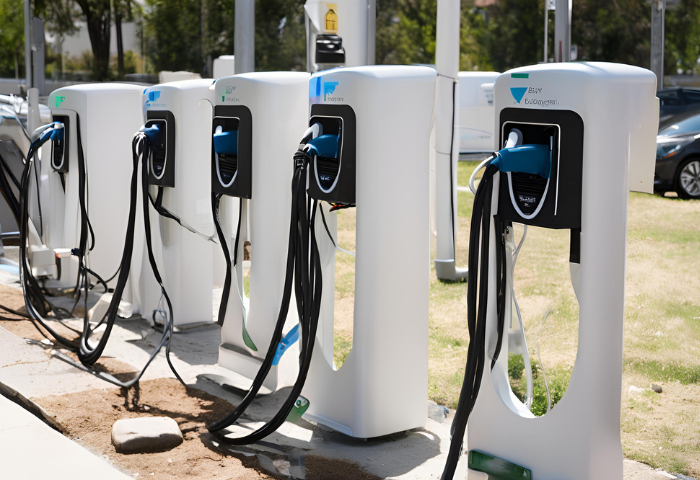
Ownership Models (Public vs Private vs Partnership)
| Ownership Model | Description |
| Public Ownership | Governmental organizations, utilities, or other public agencies own and manage the charging infrastructure, which is accessible to all EV drivers and supports larger societal goals. |
| Private Ownership | Charging infrastructure is owned and operated by private companies or organizations, often located on private property such as businesses, parking facilities, or shopping centers. |
| Partnership | Charging infrastructure is owned and operated through partnerships between public and private entities, combining resources, expertise, and investment to deploy and manage charging networks. |
Revenue Streams and Profitability Analysis
| Revenue Stream | Description |
| Charging Fees | Typically, EV drivers pay charging fees based on the number of kWh consumed, the length of the charging session, or flat-rate pricing models. |
| Membership/Subscriptions | Revenue generated from membership or subscription fees paid by users for access to exclusive charging services, priority charging, discounted rates, or other membership benefits. |
| Network Access Fees | Revenue generated from network access fees paid by charging station hosts or network partners for participating in charging networks and accessing network management services, billing, and user authentication. |
| Advertising and Sponsorships: | Revenue generated from advertising placements, sponsorships, or partnerships with brands, businesses, or advertisers seeking exposure to EV drivers and charging infrastructure users. |
| Ancillary Services | Revenue generated from ancillary services such as parking fees, convenience store sales, food and beverage sales, or other amenities offered at charging locations to enhance the user experience and increase revenue streams. |
| Demand Response Programs | Revenue generated from participating in demand response programs, where charging infrastructure operators receive payments or incentives for adjusting charging rates or schedules in response to grid conditions or utility signals,. |
| Energy Market Participation | Revenue generated from participating in energy markets, such as wholesale electricity markets or grid services markets, where charging infrastructure operators monetize flexibility in charging demand or energy storage capabilities. |
| Data Analytics Services | Revenue generated from data analytics services includes providing insights, analytics, and reports on charging infrastructure usage, energy consumption patterns, user behavior, and other data-driven insights to stakeholders. |
Understanding these cost factors is crucial for stakeholders involved in deploying, operating, or investing in Level 3 EV charging infrastructure. Proper cost analysis and planning can help optimize investment decisions and ensure the long-term sustainability and viability of charging projects.

Henry Michael is a leading expert in EV charging station research, specializing in innovative solutions for electric vehicle infrastructure. With a passion for sustainability and technological advancement, he is dedicated to advancing the accessibility and efficiency of EV charging worldwide.
